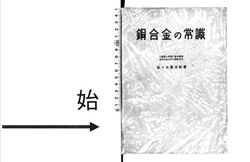File:NDL1060323 銅合金の常識.pdf

Original file (5,975 × 3,875 pixels, file size: 57.71 MB, MIME type: application/pdf, 100 pages)
Captions
Captions
Summary
[edit]| 銅合金の常識
( |
|||||||||||||||||||||||||||
|---|---|---|---|---|---|---|---|---|---|---|---|---|---|---|---|---|---|---|---|---|---|---|---|---|---|---|---|
| Author |
佐々木, 新太郎, 1887-1951 |
||||||||||||||||||||||||||
| Title |
銅合金の常識 |
||||||||||||||||||||||||||
| Publisher |
金属社 |
||||||||||||||||||||||||||
| Language | jpn | ||||||||||||||||||||||||||
| Publication date |
1943 昭和18 |
||||||||||||||||||||||||||
| Place of publication | JP | ||||||||||||||||||||||||||
| Source |
institution QS:P195,Q477675 |
||||||||||||||||||||||||||
| Creator InfoField | 佐々木新太郎 著 | ||||||||||||||||||||||||||
| Publication Place InfoField | 東京 | ||||||||||||||||||||||||||
| Subject: NDC InfoField | 565 565.2 | ||||||||||||||||||||||||||
| Extent InfoField | 174p ; 22cm | ||||||||||||||||||||||||||
| Material Type InfoField | Book | ||||||||||||||||||||||||||
| Source Identifier: JPNO InfoField | 46018763 | ||||||||||||||||||||||||||
| Date Digitized: W3CDTF InfoField | 2010-03-31 | ||||||||||||||||||||||||||
| Audience InfoField | 一般 | ||||||||||||||||||||||||||
| Title Transcription InfoField | ドウ ゴウキン ノ ジョウシキ | ||||||||||||||||||||||||||
| Publisher Transcription InfoField | キンゾクシャ | ||||||||||||||||||||||||||
| Source Identifier: NDLBibID InfoField | 000000680142 | ||||||||||||||||||||||||||
| Call Number InfoField | 565.2-Sa75ウ | ||||||||||||||||||||||||||
| Creator Transcription: NDLNA InfoField | ササキ, シンタロウ | ||||||||||||||||||||||||||
| Creator: NDLNAId InfoField | 00067501 | ||||||||||||||||||||||||||
| Contents InfoField | 標題
第1節 亞鉛含有量の相違に依る機械的性質と用途との關係/17 E 六四眞鍮にマンガン,鐵,アルミニウムを加へた合金に就て/119 索引/175 |
||||||||||||||||||||||||||
Licensing
[edit]This image is in the public domain because it is a mere mechanical scan or photocopy of a public domain original, or – from the available evidence – is so similar to such a scan or photocopy that no copyright protection can be expected to arise. The original itself is in the public domain for the following reason:
This tag is designed for use where there may be a need to assert that any enhancements (eg brightness, contrast, colour-matching, sharpening) are in themselves insufficiently creative to generate a new copyright. It can be used where it is unknown whether any enhancements have been made, as well as when the enhancements are clear but insufficient. For known raw unenhanced scans you can use an appropriate {{PD-old}} tag instead. For usage, see Commons:When to use the PD-scan tag. |
File history
Click on a date/time to view the file as it appeared at that time.
| Date/Time | Thumbnail | Dimensions | User | Comment | |
|---|---|---|---|---|---|
| current | 06:36, 9 December 2023 |  | 5,975 × 3,875, 100 pages (57.71 MB) | Wmr-bot (talk | contribs) | 上載《1060323.pdf》 |
You cannot overwrite this file.
File usage on Commons
The following page uses this file:
Metadata
This file contains additional information such as Exif metadata which may have been added by the digital camera, scanner, or software program used to create or digitize it. If the file has been modified from its original state, some details such as the timestamp may not fully reflect those of the original file. The timestamp is only as accurate as the clock in the camera, and it may be completely wrong.
| Short title | |
|---|---|
| Author | |
| Keywords | https://commons.wikimedia.org/wiki/Commons:Library_back_up_project |
| Conversion program | PyPDF2 |
| Encrypted | yes (print:yes copy:no change:no addNotes:no algorithm:AES-256) |
| Page size | 2868 x 1860 pts |
| Version of PDF format | 1.7 |




